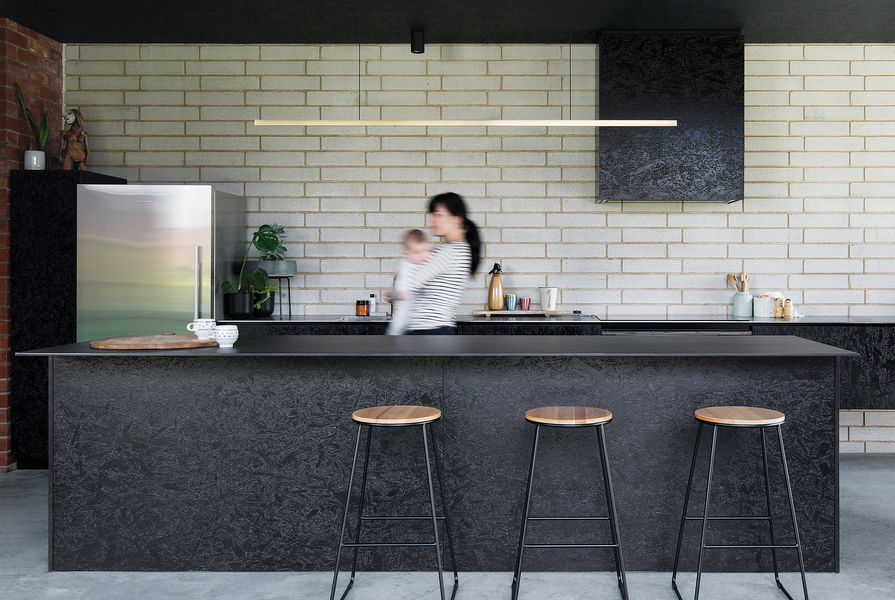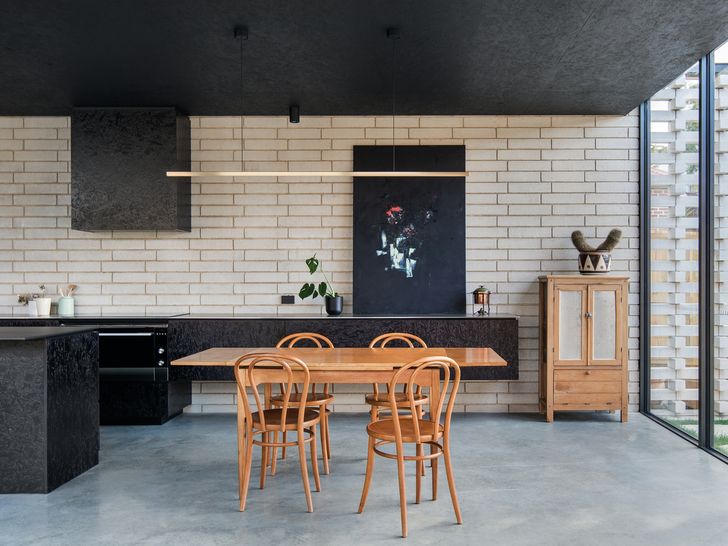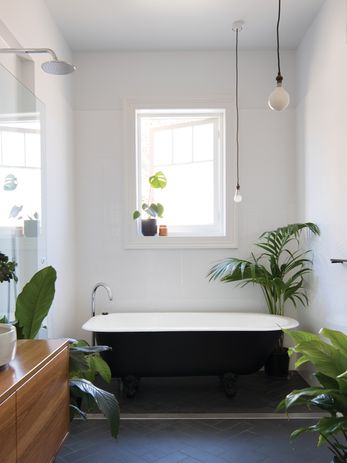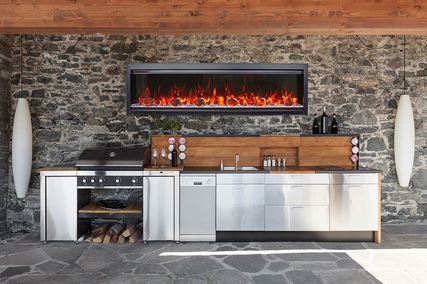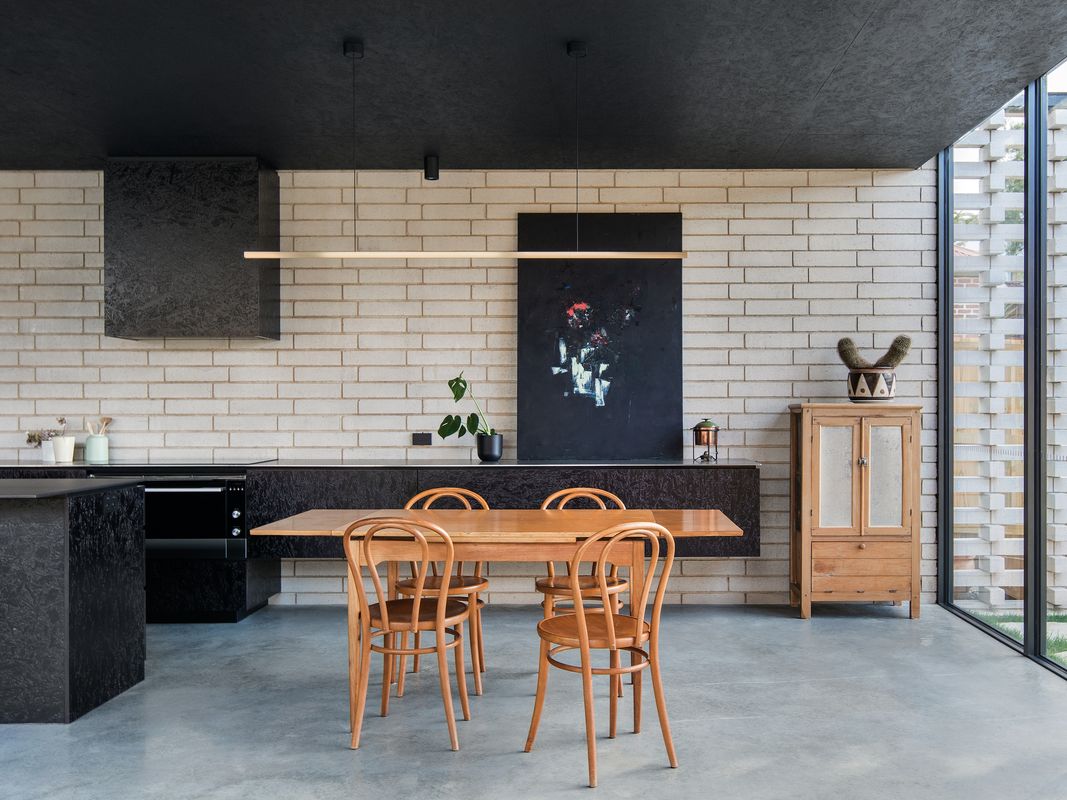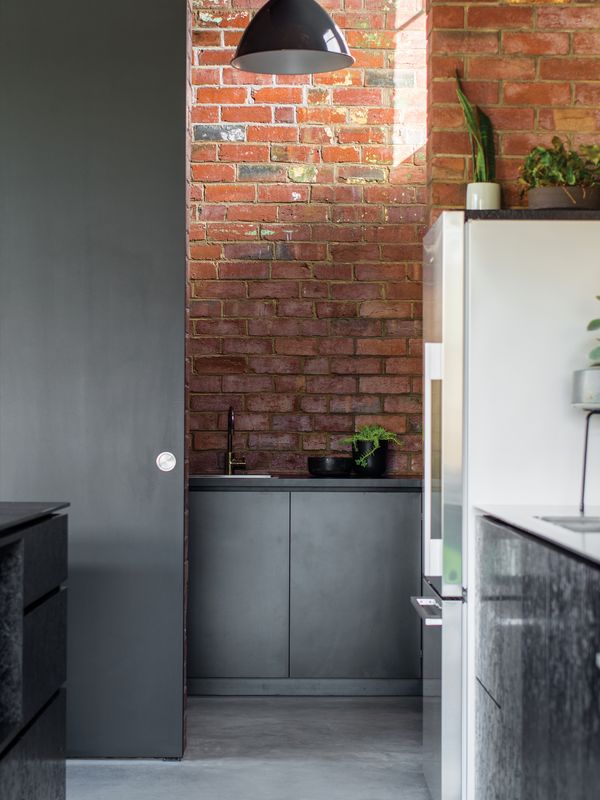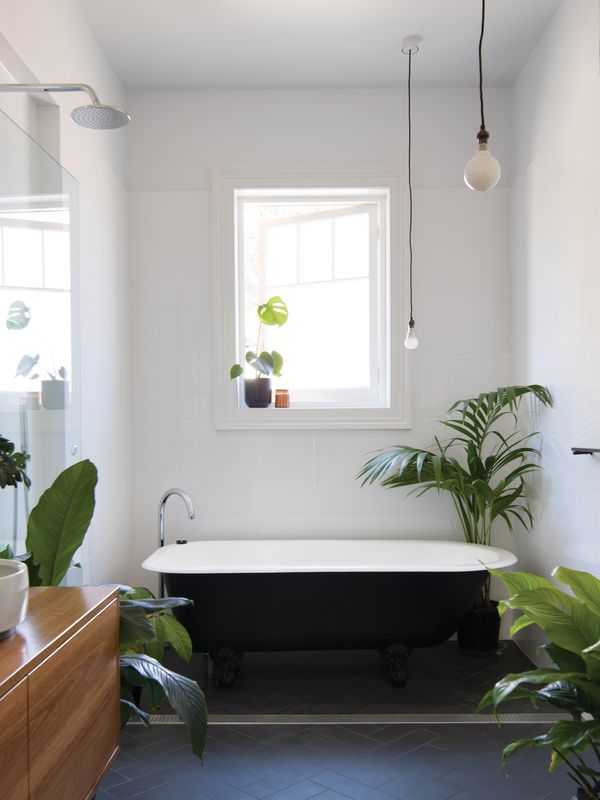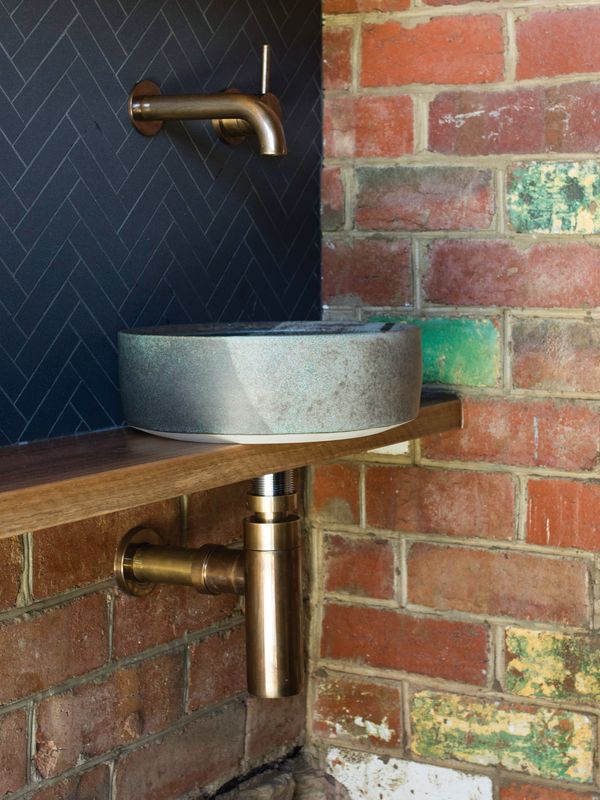For homeowners Nicola and Matt, realizing their family home has been something of a long game. As old friends of Archier director Chris Gilbert, they had had many informal conversations about renovating their 1920s brick house in West Hobart, but it was some years until they felt ready to commit to the project. When the time came, they challenged Archier to find a way to add new space without leaving the garden as an afterthought.
A rear addition reframes the connection to the backyard, wrapping living spaces around it to create a walled courtyard garden and second, smaller courtyard. The extension sits lower than the original cottage, emphasizing the sloping site and creating a clear vertical distinction between old and new.
Robust materials such as concrete, OSB and brick will wear well, without the need for applied finishes. Artwork: Nathan Grey.
Image: Benjamin Hosking
A linear organization pervades the new addition, lengthening the space and drawing the eye toward the two courtyards. Wall-hung kitchen cabinets continue into the dining space and slimline benchtops are consistent with this graphic sensibility. Suspended above the island, a brass Highline pendant, designed by Archier, emphasizes this constant horizontal form.
In the kitchen, the textured oriented strand board (OSB) cupboards and sheen of the black finish offer a tactile and tonal contrast to the white brick walls and sunlit courtyards. The island benchtop is a slender sheet of Dekton, while the benchtop on the wall joinery is made from a solid five-millimetre-thick steel plate, rather than the more common solution of wrapping a benchtop in a thin sheet of stainless steel. Both cost-effective and robust, the steel plate is “like a butcher’s block,” says director Josh FitzGerald – more durable than the typical folded steel sheet, yet also predisposed to showing signs of wear. “The way you use the kitchen will be embedded into the surface over time,” he explains. This fascination with materials that will improve with wear is a common thread. Walls are in white brick (a counterpoint to the exposed red brick of the existing house) and timber, and the ceiling is in OSB – all of which will endure daily use better than paint finish on plaster-board might.
The main bathroom has been subtly modernized. A restored clawfoot bath is paired with otherwise restrained details.
Image: Benjamin Hosking
In the main bathroom, located in the old structure, the intent was to modernize the space yet respect the age of the 1920s cottage. A restored clawfoot bath is the feature in an otherwise restrained palette of white wall tiles, Tasmanian oak vanity and chrome fittings. On the floor, grey tiles in a herringbone pattern complement the traditional aesthetic. A simple but inspired decision to include a pivoting shower screen allows the family to swivel the screen out of the way when bathing their children. A recess in the wall houses the shower fittings and allows the screen to sit tidily against the wall as needed.
The former laundry has been modified to accommodate a powder room and pantry. The powder room, tight in plan but generous in volume, features minimal incursions to the old brick walls and sandstone footings. Two oak shelves frame a handmade basin by local ceramicist Lindsey Wherrett. The sculptural piece in lichen green was something of an experiment for Lindsey and Archier, and credit is due to clients Nicola and Matt for trusting Archier to use their house as a testing ground for new commissions like this.
Josh credits homeowner Nicola more as collaborator than client. With her involvement the design evolved and morphed into a sleeker aesthetic than Archier had first anticipated, and as project manager she resolved many of the issues that arose during the build. As a result, she and partner Matt not only understand the design process, but also appreciate how the little idiosyncrasies and imperfections are an integral part of the end result.
Products and materials
- Kitchen products
- (see below)
- Internal walls
- Original exposed red brick; Adbri Masonry half-height smooth stone blockwork
- Flooring
- Burnished concrete slab
- Joinery
- Black-stained oriented strand board (OSB) cupboard fronts; Dekton and stainless steel benchtops
- Lighting
- Archier Highline suspended light
- Sinks and tapware
- Astra Walker tapware, stainless steel sinks
- Appliances
- Fisher and Paykel DishDrawer, pyrolytic oven, induction cooktop, PowerPack rangehood and fridge
- Windows and doors
- Capral double-glazed windows and doors; Tasmanian oak sliding entrance door
- Furniture
- Thonet No. 14 Vienna dining chairs
- Other
- Lindsey Wherrett Ceramics tableware and planters
- Bathroom products
- (see below)
- Internal walls
- Stack bond ceramic tiles in matt
- Flooring
- Herringbone porcelain tiles in matt grey
- Joinery
- Custom Tasmanian oak joinery
- Lighting
- Exposed globes; concealed LED strip lighting
- Tapware and fittings
- Sussex Scala wall- and floor-mounted outlets, mixers, showerhead and handshower
- Sanitaryware
- Handmade basin by Lindsey Wherrett Ceramics in collaboration with Archier; restored clawfoot bath
- Other
- Ashfield towel rail and toilet roll holder designed by the architect
Credits
- Project
- Willisdene by Archier
- Architect
- Archier
Melbourne, Vic, Australia
- Project Team
- Josh FitzGerald, Chris Haddad, Chris Gilbert, Jon Kaitler
- Consultants
-
Builder
Jak Allie Constructions
ESD Red Sustainability Consultants
Engineer Aldanmark
Joinery Impressions Building and Joinery New Town
- Site Details
-
Location
Hobart,
Tas,
Australia
- Project Details
-
Status
Built
Completion date 2017
Category Residential
Type Alts and adds
Source

Project
Published online: 22 Sep 2022
Words:
Alexa Kempton
Images:
Benjamin Hosking
Issue
Houses: Kitchens + Bathrooms, June 2018

